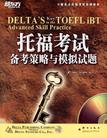托福考试备考策略与模拟试题
出版时间:2012-9 出版社:群言出版社 作者:加拉格尔 页数:707 字数:1028000
Tag标签:无
内容概要
本书是一本适用于中、高级英语水平的读者备考托福考试的综合技能强化教程。书中内容超越了应试需求,不仅能帮助托福考生做好考前准备,同时又侧重于英语语言技能的全方位提高,为考生顺利完成学业进行必要的语言训练。书中包含35个语言技能训练单元和1200多道模拟试题,题目难度与真题高度相仿,是托福备考的必备教材,也可作为提高阅读、听力、口语和写作技能的首选参考书。
本书优势卖点:
35个包含阅读、听力、口语及写作的语言技能训练单元,有效帮助考生科学备考
4套完整的全真强化试题,1200多道经典测试题目,涵盖托福考试全部题型,全方位强化应试技能
全书结构安排合理,每部分都提供了透彻的题型分析和精辟有效的考试技巧与策略
为考生设置了15周的学习计划,提供大量练习资料
特设进度表格,有利于考生自我监督学习进度
随书配有550分钟录音光盘,模拟真实考场情境,强化训练口语和听力
作者简介
Nancy
Gallagher,美国资深教育专家,有20余年英语教学与教材编写经验,著有《托福考试备考策略与模拟试题》、《新托福考试冲刺试题》、《新托福考试核心语法》等畅销备考书籍,深受托福考生欢迎。
书籍目录
INTRODUCTION
The TOEFL iBT®
The Test Score
How to Use This Book
Sample Course Outlines
PART 1 –
READING
Reading Passages and
Questions
Strategies for the Reading Section
11 Understanding Facts and
Details
12 Identifying Negative Facts
Quiz 1
Quiz 2
13 Understanding Vocabulary in Context
Quiz 3
Quiz 4
14 Making
Inferences
15 Determining Purpose
Quiz 5
Quiz 6
16 Recognizing
Paraphrases
17 Recognizing
Coherence
Quiz 7
Quiz 8
18 Summarizing Important
Ideas
19 Organizing Information
Quiz 9
Quiz 10
PART 2 – LISTENING
Conversations and
Questions
Lectures and Questions
Strategies for the Listening
Section
21 Identifying the Topic and Main
Idea
22 Listening for
Details
Quiz 1
23 Determining Attitude and
Purpose
Quiz 2
Quiz 3
24 Making Inferences and Predictions
Quiz 4
Quiz 5
25 Understanding
Function
26 Listening for Organization
Quiz 6
Quiz 7
Quiz
8
PART 3 – SPEAKING
Independent Speaking Tasks
Integrated Speaking
Tasks
Strategies for the Speaking Section
31 Independent Speaking: Developing a Topic
32 Independent Speaking: Stating and Supporting a
Position
33 Independent Speaking: Clarity and
Coherence
34 Evaluating Independent
Speaking
Quiz 1
Quiz 2
Quiz 3
35 Integrated Speaking: Connecting
Information
36 Integrated Speaking: Taking
Notes
37 Integrated Speaking: Delivering Your
Response
38 Integrated Speaking: Summarizing a
Problem
39 Integrated Speaking: Summarizing
Information
310 Evaluating Integrated Speaking
Quiz 4
Quiz 5
Quiz 6
Quiz 7
Quiz 8
PART 4 – WRITING
The Integrated Writing
Task
The Independent Writing Task
Strategies for the Writing Section
41 Integrated Writing: Connecting Information
42 Integrated Writing: Taking and Using Notes
43 Integrated Writing: Developing Your
Response
44 Integrated Writing: Sentence Structure
45 Evaluating Integrated Writing
Quiz 1
Quiz 2
Quiz 3
46 Independent Writing: Prewriting
47 Independent Writing: Stating and Supporting an Opinion
48 Independent Writing: Unity and Coherence
49 Independent Writing: Sentence Variety and Word
Choice
410 Evaluating the
Essay
Quiz 4
Quiz 5
Quiz 6
Quiz 7
Quiz 8
TEST 1
TEST 2
TEST 3
TEST 4
ANSWER KEY
AUDIO
SCRIPTS
INDEX
PROGRESS CHARTS
章节摘录
QUESTIONS 7-10 1 Long ago, people looked up in the sky and noticed groups of stars that looked like pictures. These patterns of stars, constellations, have been part of human culture for thousands of years. Ancient Syrians and Babylonians named many constellations and created stories about them. The Greeks and Romans later adopted these constellations and translated their names and stories into their own language. After the decline of these ancient cultures, most knowledge of constellations remained hidden in private libraries. Beginning in the eighth century, scholars rediscovered this knowledge. The study of astronomy spread quickly throughout the Mediterranean world, becoming part of university study. Astronomers identified many constellations only a few centuries ago. When Western astronomers started traveling to South Africa in the seventeenth century, they found numerous brilliant stars in the Southern sky. They named some of these Southern constellations after the scientific inventions of the time, such as the Microscope and the Air Pump. 2 Today's astronomers view constellations simply as areas of the sky where interesting objects await observation and study. The entire sky is divided into 88 such regions. In the 1920s, the International Astronomical Union established the boundaries of these regions. In each region, astronomers give Greek letters to a constellation's brighter stars, usually in order of brightness. Hence, the "alpha star" is the brightest star of that constellation. Scientists and ordinary people still refer to many constellations by their popular names, for example, the Lion, the Hunter, and the Great Bear. 7.Which of the following can be inferred from paragraph 1? A Constellations have interested people for very long time. B People once believed incorrect stories about constellations. C Ancient cultures disagreed about the shapes of constellations. D Most knowledge of constellations has been lost forever. 8. It can be inferred from paragraph 1 that the ancient Greeks and Romans A were the first people to notice patterns of stars in the sky B built universities all over the Mediterranear region C hid knowledge of constellations in private libraries D acquired knowledge of constellations from earlier cultures 9. It can be inferred from paragraph 2 that A there are no constellations in some areas of the sky B scientists today continue to study constellations C the boundaries of the constellations change every year D the International Astrononucal Union no longer exists 10. According to paragraph 2, which of the following statements is most likely true? A Future scientists will divide the sky into fewer regions. B There are no more constellations for scientists to discover. C A constellation's alpha star is the one that is easiest to see. D Few people know the traditional names of constellations. ……
图书封面
图书标签Tags
无
评论、评分、阅读与下载
用户评论 (总计6条)
- 送给远方的孩子
- 托福考试攻略
- 学习英语这许多年。
- 李校来的经典
- 新东方·托福考试备考策略与模拟试题
- 备考托福
